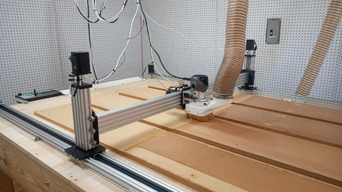Openbuilds 4x8 cnc
Discussion in 'CNC Mills/Routers' started by Sam Keller, Aug 14, 2020.
Openbuilds 4x8 cnc
Discussion in 'CNC Mills/Routers' started by Sam Keller, Aug 14, 2020.
I built this cnc using 2 z axis actuators thinking it would minimize deflection and it seems to be very sturdy. I used 2 1500mm c channels for my x axis, 1 1500mm c channel for my y axis, nema 23 stepper motors, dm556 drivers, 2 24v power supplies, smc5-5-n-n controller, 9mm wide belts, and the Hitachi m12vc router. So far it's working very well with a few hiccups. Programming the controller was a learning experience but I'm very happy with it.
Page 9 of 9
Page 9 of 9
